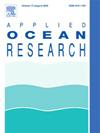Regional frequency analysis of extreme significant wave heights with long return periods based on complete distribution characteristics
IF 4.4
2区 工程技术
Q1 ENGINEERING, OCEAN
引用次数: 0
Abstract
Reliable assessment of extreme significant wave heights is crucial to the design and operation of ocean structures. However, due to the limited duration of available wave data, the uncertainty of return significant wave heights based on at-site extreme wave analysis may be large, especially for long return periods. In this study, a clustering method for identifying homogeneous regions is proposed, which directly diagnoses the frequency distribution of extreme samples to fully detect the distribution characteristics, rather than using statistical parameters of extreme samples to partially characterize this distribution. By standardizing extreme samples, measuring distribution differences, and iteratively calculating clustering centers, three homogeneous regions are identified in the study region. The diagnostic results of goodness-of-fit test show that the generalized extreme value distribution generally performs well in these regions. In each homogeneous region, the regional quantile is constructed based on all extreme samples within this region, and the site-dependent scale factor is used to extrapolate the quantile for each site. Compared with the traditional clustering method, the fitting performance of the model quantile based on the proposed method is generally improved, especially near the boundary of the homogeneous region. Compared with the at-site extreme wave analysis, the uncertainty of the return significant wave height extrapolated by the regional frequency analysis is generally reduced, especially for long return periods. For example, the width of the 95 % confidence interval for the 200-year return level is reduced by approximately 2 times at all study sites. In the homogeneous region, the distribution characteristics of extreme samples are similar due to the influence of some factors, such as driving weather. Sample information from all sites in this region can be used to describe the common distribution characteristics to construct a stable regional quantile, which is essential for extrapolation with long return periods.
基于完整分布特征的长重现期极端显著波高区域频率分析
极端有效浪高的可靠评估对海洋构筑物的设计和运行至关重要。然而,由于可用波浪数据的持续时间有限,基于现场极端波分析的返回有效波高的不确定性可能很大,特别是对于长返回周期。本研究提出了一种识别均匀区域的聚类方法,该方法直接诊断极端样本的频率分布,以充分检测分布特征,而不是使用极端样本的统计参数来部分表征该分布。通过标准化极值样本,测量分布差异,迭代计算聚类中心,确定了研究区域内的三个均匀区域。拟合优度检验的诊断结果表明,广义极值分布在这些区域总体上表现良好。在每个均匀区域中,基于该区域内的所有极端样本构建区域分位数,并使用与站点相关的尺度因子外推每个站点的分位数。与传统的聚类方法相比,基于该方法的模型分位数的拟合性能普遍提高,特别是在均匀区域边界附近。与现场极值波分析相比,区域频率分析外推的回波显著波高的不确定性普遍降低,特别是在长回波周期时。例如,在所有研究地点,200年回归水平的95%置信区间的宽度减少了大约2倍。在均匀区域,由于受行车天气等因素的影响,极端样本的分布特征较为相似。该地区所有站点的样本信息可以用来描述共同的分布特征,从而构建一个稳定的区域分位数,这对于长回归期的外推是必不可少的。
本文章由计算机程序翻译,如有差异,请以英文原文为准。
求助全文
约1分钟内获得全文
求助全文
来源期刊

Applied Ocean Research
地学-工程:大洋
CiteScore
8.70
自引率
7.00%
发文量
316
审稿时长
59 days
期刊介绍:
The aim of Applied Ocean Research is to encourage the submission of papers that advance the state of knowledge in a range of topics relevant to ocean engineering.
 求助内容:
求助内容: 应助结果提醒方式:
应助结果提醒方式:


